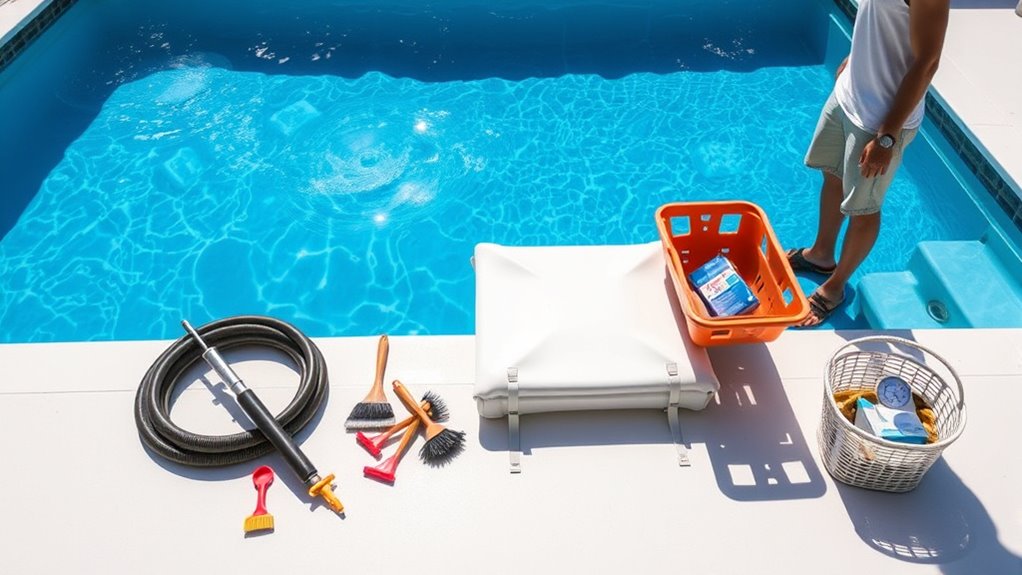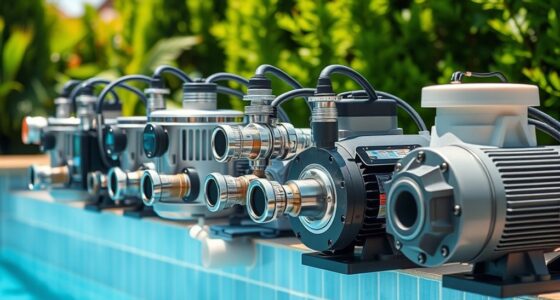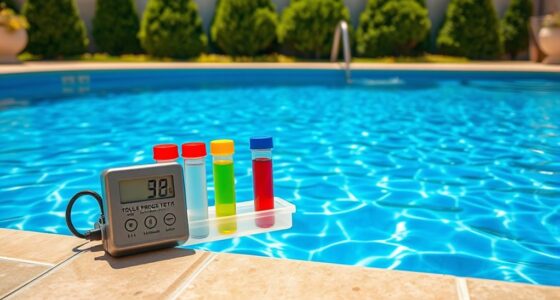To open your pool for the season, start by inspecting and removing the cover carefully, clearing away debris and checking your equipment for damage. Next, refill the pool to the proper level and brush the surfaces to loosen dirt or algae. Test and balance the water chemistry, then run your pump and filter continuously for at least 24 hours. For more detailed steps and tips, keep exploring the full process to guarantee a safe and sparkling pool.
Key Takeaways
- Inspect and remove the pool cover, clearing debris and checking equipment for damage or proper function.
- Refill the pool to the correct water level, brushing sides and bottom to remove dirt and algae residues.
- Test and adjust water chemistry, including pH, alkalinity, and chlorine levels, for safe and balanced water.
- Handle chemicals carefully, wearing protective gear, and follow safety guidelines to avoid hazardous reactions.
- Run the pump and filter continuously for 24 hours, then perform final checks and water tests before swimming.

Getting your pool ready for the season can seem like a formidable task, but with a clear plan, you can open it efficiently and enjoy it sooner. The first step is to inspect your equipment and ensure everything is in good working order. Check the pump, filter, and skimmer baskets for debris or damage, and replace or repair parts as needed. Once your equipment is ready, it’s time to remove the pool cover carefully. Be cautious to avoid debris falling into the water, and clear away any leaves or dirt from the cover. This prevents unnecessary contamination when you start filling the pool.
Inspect equipment, remove debris, and prepare the pool for a smooth opening.
Next, you need to refill your pool with fresh water. As the water level rises, it’s a good idea to brush the sides and bottom of the pool to loosen any dirt or algae that might have settled during the off-season. This prepares the surface for proper chemical treatment. Once the pool is filled, it’s essential to balance the water chemistry. Test the pH, alkalinity, and chlorine levels using a reliable test kit. Adjust these levels with appropriate pool chemicals to guarantee the water is safe for swimming. Proper chemical balance not only keeps the water clear and inviting but also helps prevent algae growth and other issues.
When handling pool chemicals, safety precautions are paramount. Always read labels carefully, wear protective gloves and goggles, and work in a well-ventilated area. Never mix different chemicals, as this can produce dangerous reactions. Store chemicals securely away from children and pets, and dispose of any unused or expired products responsibly. Maintaining correct chemical levels is vital for swimmer safety, skin protection, and the longevity of your pool equipment.
After balancing the water, run your pump and filter system continuously for at least 24 hours. This circulation ensures the chemicals distribute evenly throughout the pool. During this process, check for any leaks or unusual noises that might indicate equipment issues. Once the water chemistry stabilizes and the system runs smoothly, you can conduct a final test to confirm everything is in ideal range. If all looks good, you’re ready to add any necessary algaecides or clarifiers, and your pool is nearly prepared for swimming. Additionally, understanding optimal angles for equipment setup can help maximize your pool’s efficiency and lifespan.
Frequently Asked Questions
When Is the Best Time to Open My Pool for the Season?
You should open your pool for the season when the weather consistently stays above 50°F, typically in late spring. This allows you to perform essential pool maintenance and seasonal preparation early, avoiding algae and debris buildup. Opening at the right time guarantees your pool stays clean and safe throughout summer. Keep an eye on local temperatures to determine the most suitable moment, and don’t rush the process to enjoy a smooth swimming season.
Do I Need to Replace My Pool Cover Annually?
Think of your pool cover as a shield that guards your oasis. You don’t need to replace it every year if you perform regular pool cover maintenance, like cleaning and inspecting for damage. However, seasonal cover replacement becomes necessary if your cover shows signs of significant wear or tears. Keeping an eye on its condition guarantees your pool stays protected, saving you money and hassle in the long run.
How Do I Prevent Algae Growth After Opening?
To prevent algae growth after opening your pool, focus on algae prevention by balancing your water chemistry and applying a proper algaecide. Make certain good water circulation by running your pump regularly, which helps distribute chemicals evenly and prevents stagnant spots where algae can thrive. Keep your pH levels in check, and brush the pool walls and floor to remove any early algae buildup. Consistent maintenance is key to a clear, healthy pool season.
What Safety Precautions Should I Take During Opening?
When opening your pool, always prioritize safety by wearing appropriate safety equipment like goggles and gloves. Handle pool chemicals carefully, following manufacturer instructions to prevent spills or accidents. Keep chemicals away from children and pets, and make sure proper ventilation when working with them. Never mix chemicals, and have a first aid kit nearby. Taking these precautions helps protect you and ensures a safe, smooth pool opening process.
Can I Open My Pool if the Weather Is Still Cold?
Did you know that over 60% of pool owners delay opening their pools due to cold weather? You can open your pool during cold weather, but it’s not always ideal. Cold temperatures can cause equipment issues or freeze pipes if not prepared properly. If you decide to open your pool in cold weather, make certain you winterized it correctly and monitor the water temperature regularly to prevent damage.
Conclusion
Now that you’ve gone through the checklist, you’re all set to enjoy a sparkling pool season. Just remember, a little prep now saves a lot of headaches later. Keep up with regular maintenance, and you’ll be swimming happily all summer long. Don’t let it slip through your fingers—stay attentive, and your pool will be the highlight of your season. Plunge in with confidence, knowing you’ve got everything under control. Happy swimming!









